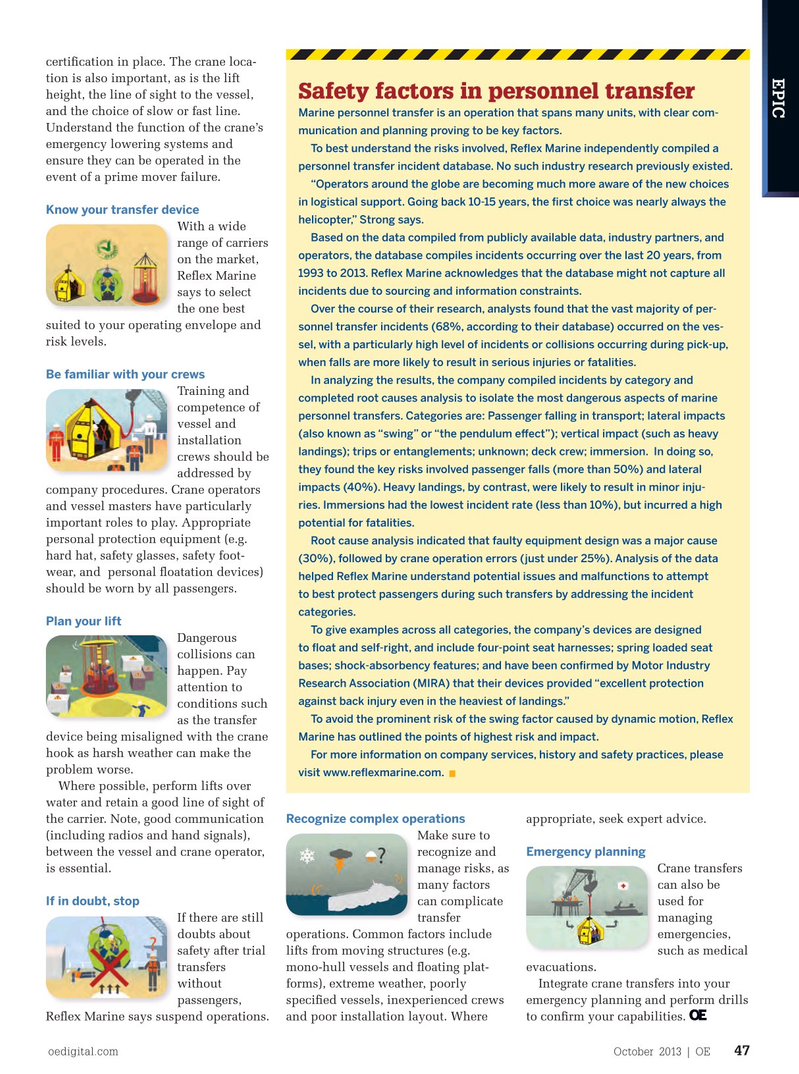
Page 45: of Offshore Engineer Magazine (Oct/Nov 2013)
Read this page in Pdf, Flash or Html5 edition of Oct/Nov 2013 Offshore Engineer Magazine
certifcation in place. The crane loca-
EPIC tion is also important, as is the lift height, the line of sight to the vessel,
Safety factors in personnel transfer and the choice of slow or fast line.
Marine personnel transfer is an operation that spans many units, with clear com-
Understand the function of the crane’s munication and planning proving to be key factors. emergency lowering systems and
To best understand the risks involved, Refex Marine independently compiled a ensure they can be operated in the personnel transfer incident database. No such industry research previously existed.
event of a prime mover failure.
“Operators around the globe are becoming much more aware of the new choices in logistical support. Going back 10-15 years, the frst choice was nearly always the
Know your transfer device helicopter,” Strong says.
With a wide
Based on the data compiled from publicly available data, industry partners, and range of carriers operators, the database compiles incidents occurring over the last 20 years, from on the market, 1993 to 2013. Refex Marine acknowledges that the database might not capture all
Refex Marine incidents due to sourcing and information constraints.
says to select the one best
Over the course of their research, analysts found that the vast majority of per- suited to your operating envelope and sonnel transfer incidents (68%, according to their database) occurred on the ves- risk levels.
sel, with a particularly high level of incidents or collisions occurring during pick-up, when falls are more likely to result in serious injuries or fatalities.
Be familiar with your crews
In analyzing the results, the company compiled incidents by category and
Training and completed root causes analysis to isolate the most dangerous aspects of marine competence of personnel transfers. Categories are: Passenger falling in transport; lateral impacts vessel and (also known as “swing” or “the pendulum efect”); vertical impact (such as heavy installation landings); trips or entanglements; unknown; deck crew; immersion. In doing so, crews should be they found the key risks involved passenger falls (more than 50%) and lateral addressed by impacts (40%). Heavy landings, by contrast, were likely to result in minor inju- company procedures. Crane operators ries. Immersions had the lowest incident rate (less than 10%), but incurred a high and vessel masters have particularly important roles to play. Appropriate potential for fatalities.
personal protection equipment (e.g.
Root cause analysis indicated that faulty equipment design was a major cause hard hat, safety glasses, safety foot- (30%), followed by crane operation errors (just under 25%). Analysis of the data wear, and personal foatation devices) helped Refex Marine understand potential issues and malfunctions to attempt should be worn by all passengers.
to best protect passengers during such transfers by addressing the incident categories.
Plan your lift
To give examples across all categories, the company’s devices are designed
Dangerous to foat and self-right, and include four-point seat harnesses; spring loaded seat collisions can bases; shock-absorbency features; and have been confrmed by Motor Industry happen. Pay
Research Association (MIRA) that their devices provided “excellent protection attention to against back injury even in the heaviest of landings.” conditions such
To avoid the prominent risk of the swing factor caused by dynamic motion, Refex as the transfer device being misaligned with the crane
Marine has outlined the points of highest risk and impact. hook as harsh weather can make the
For more information on company services, history and safety practices, please problem worse.
visit www.refexmarine.com. •
Where possible, perform lifts over water and retain a good line of sight of the carrier. Note, good communication appropriate, seek expert advice.
Recognize complex operations (including radios and hand signals), Make sure to between the vessel and crane operator, recognize and
Emergency planning is essential. manage risks, as Crane transfers many factors can also be can complicate used for
If in doubt, stop
If there are still transfer managing doubts about operations. Common factors include emergencies, safety after trial lifts from moving structures (e.g. such as medical transfers mono-hull vessels and foating plat- evacuations.
without forms), extreme weather, poorly Integrate crane transfers into your passengers, specifed vessels, inexperienced crews emergency planning and perform drills
Refex Marine says suspend operations. and poor installation layout. Where to confrm your capabilities. oedigital.com October 2013 | OE 47 046_OE1013_Epic2_reflexMarine.indd 47 9/29/13 9:47 PM

 44
44

 46
46